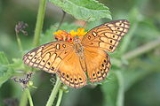
Euptoieta hegesia
Encyclopedia
The Mexican Fritillary (Euptoieta hegesia) is a North
and South America
n butterfly
in the family Nymphalidae
.
). The Variegated Fritillary has black median lines on the upper side of the hind wing, and on the underside of the hind wing it has a pale postmedian band.
, from July to December in Texas
and year-round in Mexico
.
is shiny red, with middorsal silver spots edged with black. It has a subdorsal row of white spots ringed with black, a spiracular silver line with black edges, and six rows of black spines. The red head has two long black spines with clubbed ends. The chrysalis is dark brown or rarely tan, with gold eyes and short gold lateral and subdorsal cones. On the wing cases, it has a black marking shaped like a "T". It has 1-3 brood
s per year.
North America
North America is a continent wholly within the Northern Hemisphere and almost wholly within the Western Hemisphere. It is also considered a northern subcontinent of the Americas...
and South America
South America
South America is a continent situated in the Western Hemisphere, mostly in the Southern Hemisphere, with a relatively small portion in the Northern Hemisphere. The continent is also considered a subcontinent of the Americas. It is bordered on the west by the Pacific Ocean and on the north and east...
n butterfly
Butterfly
A butterfly is a mainly day-flying insect of the order Lepidoptera, which includes the butterflies and moths. Like other holometabolous insects, the butterfly's life cycle consists of four parts: egg, larva, pupa and adult. Most species are diurnal. Butterflies have large, often brightly coloured...
in the family Nymphalidae
Nymphalidae
The Nymphalidae is a family of about 5,000 species of butterflies which are distributed throughout most of the world. These are usually medium sized to large butterflies. Most species have a reduced pair of forelegs and many hold their colourful wings flat when resting. They are also called...
.
Description
The upper side of the wings is bright orange with the basal part of the hind wing unmarked. There is a row of submarginal black spots on both the fore wing and the hind wing. The underside of the wings is yellow-orange with no submarginal black spots. It has a wingspan of 2.5 to 3 inches.Similar Species
The only similar species in the Mexican Fritillary's range is the Variegated Fritillary (Euptoieta claudiaEuptoieta claudia
The Variegated Fritillary is a North and South American butterfly in the family Nymphalidae. Even though the Variegated Fritillary has some very different characteristics from the Speyeria Fritillaries, it is still closely related to them. Some of the differences are: Variegated Fritillaries have...
). The Variegated Fritillary has black median lines on the upper side of the hind wing, and on the underside of the hind wing it has a pale postmedian band.
Flight
The Mexican Fritillary may be seen from mid-June to November in ArizonaArizona
Arizona ; is a state located in the southwestern region of the United States. It is also part of the western United States and the mountain west. The capital and largest city is Phoenix...
, from July to December in Texas
Texas
Texas is the second largest U.S. state by both area and population, and the largest state by area in the contiguous United States.The name, based on the Caddo word "Tejas" meaning "friends" or "allies", was applied by the Spanish to the Caddo themselves and to the region of their settlement in...
and year-round in Mexico
Mexico
The United Mexican States , commonly known as Mexico , is a federal constitutional republic in North America. It is bordered on the north by the United States; on the south and west by the Pacific Ocean; on the southeast by Guatemala, Belize, and the Caribbean Sea; and on the east by the Gulf of...
.
Life cycle
The larvaLarva
A larva is a distinct juvenile form many animals undergo before metamorphosis into adults. Animals with indirect development such as insects, amphibians, or cnidarians typically have a larval phase of their life cycle...
is shiny red, with middorsal silver spots edged with black. It has a subdorsal row of white spots ringed with black, a spiracular silver line with black edges, and six rows of black spines. The red head has two long black spines with clubbed ends. The chrysalis is dark brown or rarely tan, with gold eyes and short gold lateral and subdorsal cones. On the wing cases, it has a black marking shaped like a "T". It has 1-3 brood
Offspring
In biology, offspring is the product of reproduction, of a new organism produced by one or more parents.Collective offspring may be known as a brood or progeny in a more general way...
s per year.
Host Plants
Here is a list of host plants used by the Mexican Fritillary:- Foetid Passionflower, Passiflora foetidaPassiflora foetidaPassiflora foetida is a species of passion flower that is native to the southwestern United States , Mexico, the Caribbean, Central America, and much of South America...
- Yellow Alder, Turnera ulmifoliaTurnera ulmifoliaTurnera ulmifolia, the Yellow Alder, is a species of plant of family Passifloraceae, native to Mexico and the West Indies. A recent study found that yellow alder potentiated the antibiotic activity against methicillin—resistant Staphylococcus aureus ....
(used in Mexico and in the AntillesAntillesThe Antilles islands form the greater part of the West Indies in the Caribbean Sea. The Antilles are divided into two major groups: the "Greater Antilles" to the north and west, including the larger islands of Cuba, Jamaica, Hispaniola , and Puerto Rico; and the smaller "Lesser Antilles" on the...
) - Ipomoea maritima (used in BrazilBrazilBrazil , officially the Federative Republic of Brazil , is the largest country in South America. It is the world's fifth largest country, both by geographical area and by population with over 192 million people...
)

